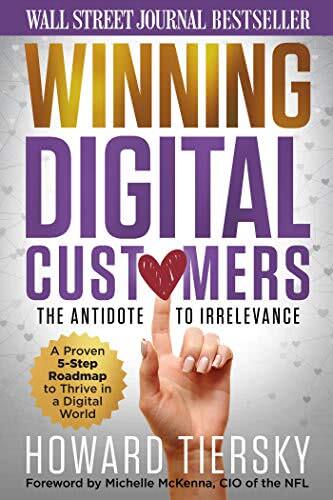
Howard Tiersky’s Four Little Fixes to Kick-Start Your Digital Transformation
Digital transformation can take months, even years. But for “legacy” brands just starting out on the journey, the little things you do up front will make an impact today.
The digital transformation of our world is roaring full steam ahead. Are you on the train? While disruptor companies are born ready to serve the needs of today’s digital customer, “legacy” organizations find reinventing their brand experience is a long, arduous journey. It can take years.
Howard Tiersky, author of the new Wall Street Journal bestseller Winning Digital Customers: The Antidote to Irrelevance says there are some small changes you can make right now that may not outright delight your customer…but will at least minimize their aggravation.
Some problems are tough to fix, but some aren’t. So, start with those.
“These quick fixes may not get your customers to outright love your brand,” concedes Tiersky. “But, if you can identify some things you are doing that confuse, frustrate, or disappoint your customers that you can just stop, that’s a step in the right direction.
“Taking these small steps might deliver quick, measurable, sustainable financial improvements, which can demonstrate to key executives that your overall transformation program is capable of driving tangible business impact,” says Tiersky. “This can help you garner funding. Second, you improve your customers’ experience, which improves brand perception and demonstrates progress.”
According to Tiersky, the bottom line is that customers today have very high expectations. If you currently have a weak user experience, it pays to address it now rather than months or years into your digital transformation. Here are some tips for getting started.
Ferret out experience glitches that might be turning off customers.
Almost every company has these types of seemingly small digital glitches in user experience that add up over time to form an impression. This becomes even more problematic when a digital disruptor offers your customers a new, shiny, digital journey that has avoided these types of flaws.
“A few years ago, United Airlines asked me for my feedback on a flight,” says Tiersky. “Nice idea, but the first line of the email read: REPLIES TO [email protected] ARE NOT MONITORED. When I kept reading, I found that lower in the message, it provided a link for me to take a survey. Clearly, they wanted my feedback; they just didn’t want the feedback via email. But the execution sent the wrong message: ‘Tell us about your recent flight! Be we aren’t actually listening to your response!’”
Get your wording right.
HubSpot[1] did a study of over 40,000 “call-to-action buttons for email sign-ups.” They found that if the text of a button read, “Click Here,” site visitors were three times more likely to click than if it read “Register.”1 Of course, that doesn’t mean that every button on your site should be labeled “Click Here,” but merely points to the importance of getting the wording right.
Proof your website (or lose customers!).
Give your website and any materials you send or publish a careful review. A few seemingly careless errors or inconsistencies can cause your potential customers to lose faith in you.
“We worked with one client selling very expensive ‘six-figure’ B2B solutions that had a website that was good in many ways, but that had a variety of small glitches, formatting irregularities, inconsistent capitalization, and other seemingly minor anomalies,” says Tiersky. “The potential customers we interviewed in research sessions regularly zeroed-in on these small defects as details that made them question the quality of the company’s products and services.
“While in truth, there was probably no direct connection between those two things, there was in the customer’s mind,” he notes. “Imagine losing a $100,000 or even $500,000 sale because of lost confidence resulting from a typo on your website.”
Get out of your lane to fix the small stuff.
“I worked with one giant retailer where all the executives agreed that the navigation menus on the $1 billion-plus e-commerce site were confusing,” says Tiersky. “Yet nothing was done to fix them because nobody considered it their job. One executive focused on merchandising, one on pricing and promotions, and one on checkout processes, but there was no clear owner of cross-site navigation. Nobody wanted to step on toes or go outside of their mandate. So, it stagnated, despite the fact that everybody’s bonus was tied to total sales, and the menus were clearly turning off some customers.”
The lesson: When everyone agrees that there is a problem that negatively impacts the customer’s experience, step up and deal with it. First, ask who should be in charge of fixing it. If there’s no obvious answer, form a new task force and get to work. Easy fixes should never be delayed.
Relatively quick-and-easy fixes can go a long way Tiersky emphasizes. If you fix 100 things like these this quarter, and then 100 more next quarter, over time you can have a substantial impact.
“Digital transformation is a marathon, not a sprint,” ads Tiersky. “The impactful changes you make now will add to your momentum down the road.”
________________________________________
[1] Dan Zarrella, “Don’t ‘Submit’ To Landing Page Button Text,” HubSpot, October 8, 2010. wdc.ht/17.1

Howard Tiersky is the author of the Wall Street Journal bestseller Winning Digital Customers: The Antidote to Irrelevance. He has been named by IDG as one of the “Top 10 Digital Transformation Influencers to Follow Today.” As an entrepreneur, he has launched two successful companies that help large brands transform to thrive in the digital age: FROM, The Digital Transformation Agency and Innovation Loft. His dozens of Fortune 1000 clients have included Verizon, NBC, Viacom, Avis, Universal Studios, JPMC, Crayola, Morgan Stanley, Condé Nast, the NBA, Visa, and digital leaders like Facebook, Spotify, and Amazon.
Editor's Note:
Digital trandsformations have been going on a long time, and it seems COVID-19 has stepped everything up. What it boils down to essentially is shaing your brand digitally. In addition to Howard’s advice, a good branding overview can be found oin What is a Brand? Also, there is a series of articles emphasizing the need to digitally transform called Navigating Sales and Marketing during COVID-19. There are individual articles on architecture, manufaturing, retail, security and a host of other markets covered in individual, thought-provking essays. Also, read Jim Nowakowski’s Review of Howard’s book — How Do Customers Love Thee? Let Howard Tiersky Count the Ways — on our own website in the blog section.